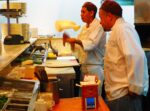The UK’s Competition and Markets Authority (CMA) has referred it’s proposed acquisition of Hungryhouse for an “in-depth investigation“. A Just Eat CMA investigation could derail the proposed merger. The deal, which was announced in December 2016, requires CMA approval to go ahead. The CMA launched it’s merger inquiry on the 10th of March and gave Just Eat the opportunity to address concerns about how the merger could lead to worse terms for restaurants using either company. The CMAs initial investigation found that both provide online takeaway ordering services, giving restaurants the opportunity to reach a wide pool of people, as well as offer customers the convenience of choosing from a large range of takeaway providers in one place.
The result of the investigation will not be known until November 2, 2017.

An example of the lack of sophistication of many restaurant owners is that they promote the Just Eat brand over theirs.
Why is the CMA investigating Just Eat?
The Just Eat business model is to aggregate customers and aggregate restaurants and place themselves in between the restaurant and their customers and clipping the ticket on the way through, generally earning commission in excess of 10%. The don’t provide the restaurants phone number to the customer until after an order is made, nor do they provide the restaurant with the email address of the customer.
The effect of this is quite insidious, because it feeds into the customer database for Just Eat and leaves many of their small restaurant partners with no email database. The asymmetric information capabilities between Just Eat and the small restaurant operators is exacerbate because many do not understand that they should be collecting the email addresses and running their own marketing campaigns. Just Eat is already blamed for some of the independents woes, with the effect that Just Eat having on the market being described as “crippling,” and “One of the biggest reasons why takeaways are struggling is Just Eat.”
The power of the database grows as more consumers are in it and each of them orders more often. Just Eat is able to determine the likelihood and type of cuisine that a person will order and can use in app or emails to direct the consumer to a restaurant that is prepared to pay Just Eat a higher commission.
A decrease in competiton would leave all of the small restaurants at the mercy of Just Eat, which will have a very powerful digital monopoly. The barriers of entry, which include building a two sided marketplace and the cost of selling to each restaurant, mean that it is very unlikely that any new competitors will be able to enter the market once Just Eat achieves dominance. At least with Hungryhouse operating apart from Just Eat, there is a some semblance of competition, although rising commissions could give the impression of a cosy duopoly.
What about UberEATS and the other competitors to Just Eat?
The CMAs initial investigation found that Deliveroo, UberEATS and Amazon Restaurants represent less direct competition have less extensive geographic coverage as well as targeting restaurants which have traditionally be dine in only.
Companies offering online services along with the delivery provide a three sided marketplace. They require delivery drivers/riders, restaurants and the customers. A concentration of restaurants and consumers is required to provide the work required for the drivers. Given the high volumes compressed into short time frames, eg Friday and Saturday night, it is very difficult to build these services outside of very high density living areas.
The Just Eat CMA inquity can result in the merger being allowed, in the merger having some restrictions placed on it, or the merger may not be given permission to go ahead.
Menulog and Eat Now – the Australian example of what could happen
Australia went through a similar experience with the merger of Menulog and Eat Now, which is now under investigation from the ACCC – the Australian Competition and Consumer Commission. Incidentally, Menulog is also being investigated for brandjacking, a practice that is still going on today. Brandjacking occurs when a website is set up by a third party and consumers use it believing that they are dealing direct with the restaurant, when in fact they are dealing with the online ordering company. The online ordering company can then report back to the restaurant how many orders they’ve generated for the restaurant, when in reality, these orders where from the the restaurants own customers who would have probably dealt with them anyway.
Following the merger of Eat Now and Menulog, which were strong 1st and 2nd places as far as market share went, they were able to consolidate their leading position to the extent that Delivery Hero closed it’s business in Australia. This has left virtually all Australian restaurants with the single choice of the combined Menulog/Eat Now if they are located outside the small area covered by Deliveroo and UberEATS.
Commissions charged by Menulog / Eat Now prior to the merger where generally around 10%, and this has risen to 13%, and we have seen various sales promotions that have seen pricing charged to restaurants dramatically higher than this. Without the competition of a strong number 2 player, Menulog is now able to dictate terms to the Restaurants. The effect that this is having is not insignificant. We are dealing with an increasing number of restaurant owners who feel powerless and very pessimistic about the future of their restaurants given their inability to deal with the marketing and pricing power of Menulog.
It will be interesting to see the outcome of the Just Eat CMA investigation and what the long term effects will be on the industry.
Free Alternatives to Just Eat and Hungryhouse
Just Eat works for restaurants prepared to not bother about their own marketing in return for becoming a price taker for prices as determined by Just Eat, partially in the commission they charge and partially on the promotions that they are sometimes need to participate in to maintain order volumes. The platform allows for little differentiation, apart from reviews, which can be problematic, especially in the restaurant industry.
For restaurants looking for alternatives, our Free Restaurant OnLine Ordering, FROLO, system allows you to take orders online, take payments online, enjoy all of the benefits for your customers, without giving up the email address or having other companies see who your best customers. We don’t make any money out of FROLO, but it was a feature built for our website customers which we give away to restaurants around the world because we don’t think you have a sustainable business if you are allowing other companies to come in between you are your customers.
Is Poor SEO Killing Your Restaurant?
Too many times we see customers with websites that are costing restaurants thousands of dollars every month through poor design, poor messaging and poor SEO. If your website could be improved to bring in 200 extra visits per month and just 10% of those made a booking, and each booking was for 2.5 seats on average at $50 a seat, you would have an extra $2,500 in revenue a month. A 30% food cost, that is $1,750 in profit extra a month. This ignores those customers coming back as regulars – which is more profit.
Remember, if these customers aren’t finding your Restaurant, they are finding your competitors.
Get one of our obligation free 7 point website SEO audits to see what you can get your web developer to fix to increase your revenue today.




